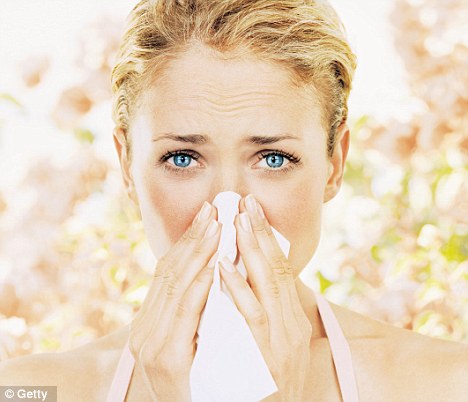From dogs to dust mites and pollen to latex, it’s thought that 40 per cent of us suffer from an allergy. But tracking down the source can be as aggravating as the condition itself.
Millions of us are unable to access allergy specialists to get a correct diagnosis and treatment, according to a report last week from the royal College of Physicians and the royal College of Pathologists.
‘There’s a huge misconception that if someone sneezes a lot then they must have hay fever,’ says Dr Adrian Morris of the Surrey Allergy Clinic.

From dogs to dust mites and pollen to latex, it’s thought that 40 per cent of us suffer from an allergy
‘However, it could be an allergy to house dust mites or cats, for example. Cat allergens can be carried on people’s clothes.
‘You may sit next to someone in the office who has a cat, but attribute your sneezing to the pollen you encountered on the way in, when it’s nothing of the sort.
‘That is why pinpointing where and when an allergy occurs is so vital.
‘While the treatment might be the same, avoiding the source is the most crucial part of tackling any allergy.’ In the absence of a specialist appointment, one way of checking for allergies is to take a new test that is now available on the High Street.
This takes half an hour and involves a pin-prick to the finger.
Available in most good chemists, it works by detecting antibodies which the body makes in response to a substance it is allergic to. It is about 96 to 98 per cent effective.
We asked ten people with typical hay fever symptoms to take the test to check for allergies to the 12 most common inhaled allergens: grass pollen, house dust mite, cat, stinging nettle pollen, hazelnut pollen, birch pollen, latex, mugwort pollen, dog and the moulds aspergillus fumigatus, alternaria alternata and cladosporium herbarum.
Amazingly, some of those who for years had thought they had hay fever did not show any obvious signs of an allergy to grass or any pollens at all. others uncovered allergies they had previously known nothing about …
CATS AND DUST MITES

Events organiser Jenny Long, 23, from Leeds , is single.
SYMPTOMS: Since she was 18, Jenny had itchy eyes and a tingly throat in the summer and sneezing all year.
She takes anti-histamines in the morning and evening during the summer and avoids sitting in grassy areas, which she thought triggered her symptoms.
RESULTS: Jenny is allergic to house dust mites and cats – as well as grass. She is also sensitive to latex.
REACTION: ‘I sneeze all year long, which now I know must be the dust mite allergy – but I thought it was year-long hay fever. Cat allergy makes sense as I recently visited a friend who had a cat and my eyes started watering and I was sneezing badly.
‘Knowing what I’m allergic to is going to make life easier.’
NETTLES AND MOULD

Personal assistant Jenny Pearce, 26, is single and lives in Poole, Dorset.
SYMPTOMS: For the past four years she has had a continually itchy throat, which her doctor has told her is hay fever. She also sneezes and gets an itchy nose.
Jenny takes anti-histamine pills all year round and thought she was allergic to grass and other pollens.
RYSULTS: Jenny did not have a strong allergy to any of the 12 airborne allergens.
She had a medium reaction to stinging nettles and birch pollen, as well as the moulds alternaria alternate and cladosporium herbarum, which is often found in houses with poor ventilation and in low, damp areas. This is the most common cause of mould allergy. It peaks in late summer and autumn. She had no allergy to grass.
REACTION: ‘I have spent years avoiding grassy places, as it turns out, unnecessarily. It looks like birch pollen must be causing my symptoms.
‘I am disappointed, because there are trees everywhere, so there is not much I can do about it.’
GRASS AND LATEX

David Wood, 28, who is single and lives in Gloucester, is the digital media officer for the Meningitis Trust.
SYMPTOMS: Since he was 11 , David has suffered from sneezing, red, watery eyes and lethargy from May until August. Some years he would also have asthma-like symptoms. He takes antihistamine tablets daily in the summer and avoids walking through meadows and areas of long grass.
RESULTS: David is allergic to grass pollen. He is also sensitive to stinging nettle pollen, hazelnut pollen, latex and the mould alternaria alternata.
REACTION: ‘This was pretty much as I expected. My symptoms have always been seasonal and became so much worse if I walked through a field that I convinced I was allergic to grass.
‘The sensitivity to latex surprised as until five years ago I worked in pathology department of a hospital and wore latex gloves daily. Maybe it’s come on as I’ve got older.’
TREES AND APPLES

Anna Fox, 31, runs own cupcake business. She lives with her boyfriend Patrick Jones, 37, who has his own recruitment firm in Birmingham.
SYMPTOMS: Since was 20, from March until September, Anna has suffered from a blocked, runny nose, itchy eyes and nose.
She also gets a tickly throat when eats apples and pears, but thought she was allergic to grass. She uses nasal sprays and antihistamine tablets from the chemist, which help.
RESULTS: Anna is allergic to grass and birch pollen. She is also sensitive to house dust mites, hazelnut pollen the moulds cladosporium herbarum and alternaria alternata.
REACTION: ‘My hay fever would always come on earlier than other people’s, which made me wonder if I had another allergy.
‘However, now I’ve discovered that birch pollen is released from March, which explains it. It also explains why my throat gets tickly when I eat apples, as a birch pollen allergy can cause a cross reaction with fruit.’
EVERYTHING

Rafi Mandelsohn, 26 , works in corporate affairs and is married with a baby. He lives in Hendon, north-west London.
SYMPTOMS: Runny nose, sneezing and watery eyes. Takes antihistamines all summer – with mixed success.
RESULTS: Rafi is allergic to house dust mites and grass pollen. He had medium reactions to cat, dog, hazelnut pollen, birch pollen and the mould alternaria alternata.
REACTION: ‘I often wake up feeling congested, which I always presumed to be hay fever but is probably due to my dust mite allergy. I have never had a cat or dog, but have noticed that I do sneeze if I go and see people with a pet. Now, I can avoid cats and dogs, plus vacuum the house more to ensure it is as dust free as possible.’
GRASS AND MOULD

Public affairs consultant Claire Mclauchlin, 27, is married to Anthony, 27, who is a wooden floor specialist. They live in Oldham, Manchester.
SYMPTOMS: Sneezing, nose bleeds, itchy ears and face, and watery eyes. Symptoms began when Claire was 15 and peak between June and August. She needs three antihistamines a day during the summer.
She once required an antihistamine shot in hospital when her throat started to close while holidaying at a country cottage in Wales. She thought she was allergic to grass and pollen.
RESULTS: Claire is allergic to grass pollen and the mould alternaria alternata.
REACTION: ‘My symptoms are so bad, I thought I had another allergy. If, for some reason, I forget to take an antihistamine and go outside in the summer, I have to quickly come back inside.
‘My eyes will start to water instantly. The mould allergy is interesting as when I recently visited a friend’s house, which was a bit damp, I became wheezy and was struggling to breathe.
‘I’m about to move house and was thinking of having my patio grassed over – now I’m not going to.’
DUST MITES

Sarazann Bhanga, 23, is a public relations executive. She is single and lives in Leamington Spa.
SYMPTOMS: Since the age of 17, Sarazann has had a severely itchy and blocked nose and suffered from sneezing and watery eyes.
The symptoms are present all year round, but seem worse in summer. Her GP diagnosed hay fever and prescribed antihistamines, which have little effect. She thought she might be allergic to a variety of pollens.
RESULTS: Sarazann is not strongly allergic to any of the 12 airborne allergens. She had only a very slight positive reaction to house dust mites and grass pollens.
REACTION: ‘Thinking about it, freshly cut grass has never really provoked a bad reaction. So maybe the dust mites are the issue.
‘My GP has been prescribing me antihistamines for years but has never tested me to check what I am allergic to.
‘I am now going to go back to my doctor for further tests for food and other allergies.’
GRASS, MOULD, TREES

Full-time mum Cathy Acratopulo, 38, is married to Mike, 41, a banker. They have two children, Isabel, five, and Thomas, seven, and live in Barnes, south-west London.
SYMPTOMS: Since her mid-20s she has sneezed all year, the symptoms being particularly bad from April until June.
Cathy also has a runny nose and sore watery eyes. She takes anti-histamine tablets, nasal spray and eye drops. She thought she was allergic to dust mites.
RESULTS: Cathy is strongly allergic to birch and grass pollen, with lighter reactions to hazelnut pollen and the moulds cladosporium herbarum and alternaria alternata.
REACTION: ‘Bizarrely, I didn’t come up positive to dust mites even though I start sneezing as soon as I wake up.
‘Maybe the mould is to blame – although I am not aware that there is any mould around my house.
‘The birch pollen allergy makes sense, as I develop a red rash around my mouth if I eat apples and there’s a known cross-reaction with fruit.’
…AND THE ‘COLD’ THAT WAS ACTUALLY HAY FEVER

Jenny Stringer is acting managing director of Leith’s School of Food and Wine. She is married to James, 38, who runs an insurance business and has two children, Thomas, five, and Ben, three. They live in Bromley, Kent.
SYMPTOMS: Itchy nose and throat, sneezing and watery eyes in the spring and summer.
The symptoms came on in Jenny’s late 20s, but as they were not severe, she put it down to summer colds and took nothing for it.
RESULTS: Jenny is allergic to grass pollen and has medium reactions to stinging nettles, hazelnut and birch pollen, as well as alternaria alternata.
This is found in soils, food, composts and forest plants and is most prevalent during warm conditions.
REACTION: ‘As a working mum I’ve never had time to think “this might not be hay fever”. I was in denial, even though the symptoms are inconvenient.
‘My job entails tasting students’ cooking. During exam time, my blocked, itchy nose made it hard to concentrate.
‘Since the test, I’ve been taking Beconase nasal spray and anti-histamine tablets, which really work.’
The FastCheck Inhalation Allergy Test costs about £50 in a chemist and £34.95 if ordered direct. Call 02476 377210 for stockists.










